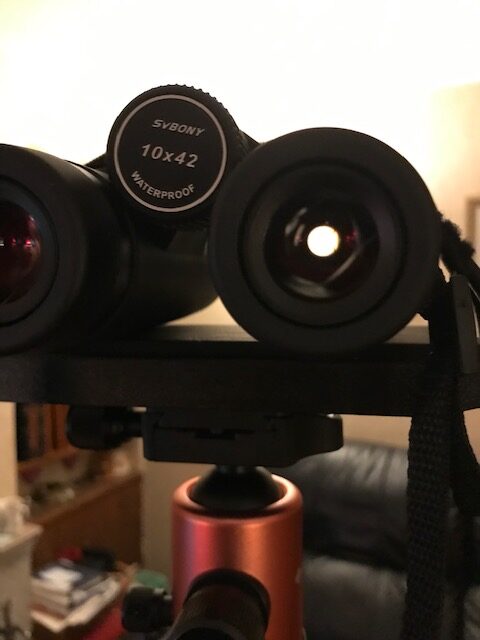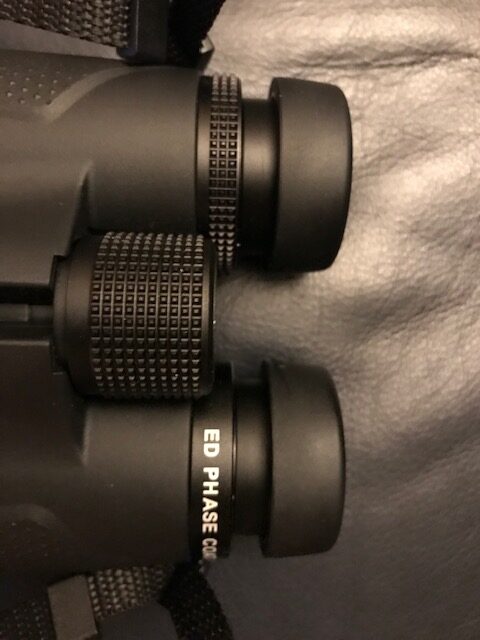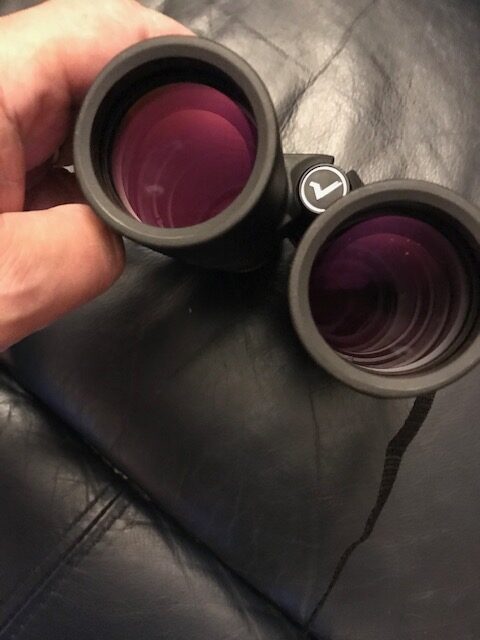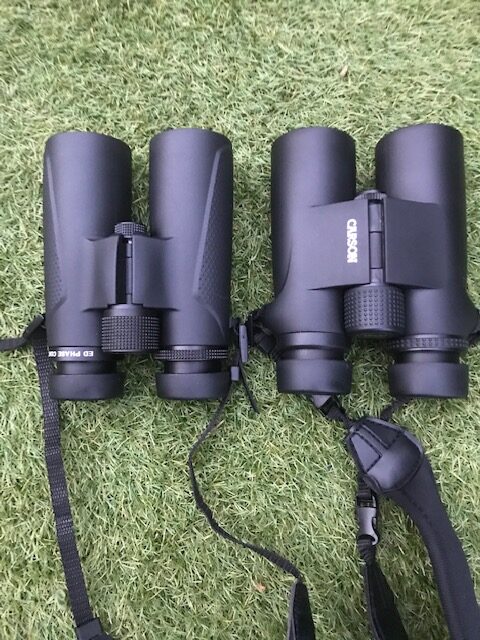
A Work Commenced September 14 2021
Dedicated to Hans Zimmer
Product: Svbony SV202 10 x 42 ED
Place of Manufacture: Hong Kong
Field of View: 108m@1000m(6.16 angular degrees)
Eye Relief: 15.1mm
Dioptre Compensation: +/- 3
Close Focus: 2.5m(advertised) 2.8m measured
Exit Pupil: 4.2mm
Chassis: Textured rubber armoured Magnesium alloy
Coatings: Fully broadband multi-coated, dielectric and phase correction coatings applied to BAK-4 prisms
ED Glass: Yes
Nitrogen purged: Yes
Waterproof: Yes IPX7
Weight: 693g(advertised) 698g measured
Dimensions: H/W: 14.9/12.5cm
Accessories: Soft padded carry bag, padded neck strap, lens cleaning cloth, rubber ocular and objective lens covers (tethered), multi-language user manual
Retail Price: £125.99(Amazon UK)
Warranty: 1 Year Limited
A couple of months back, I reviewed an extraordinary compact binocular, the Svbony SV 202 8 x 32 ED, showcased in the Preamble above. Retailing for just under £100(but now being offered for just £90), I was deeply sceptical regarding the claims made by the company, since it was offering an instrument with a raft of sophisticated features, including a magnesium alloy chassis, phase and dielectrically coated Schmidt-Pechan roof prisms and an ED element in the objective. Determined to debunk those claims, I happened to have in my possession another compact 8 x 32 – the Celestron Trailseeker – which also had many of those same features but with the exception of the ED element to compare it to. To my absolute astonishment, the claims made by the Hong Kong based Svbony turned out to be true! What’s more, the addition of the ED objective element pulled the Svbony ahead of the Trailseeker in careful optical testing. Even its ergonomic features proved superior to the very decent Celestron binocular.
Yet, it transpired that Svbony was also offering a larger glass, the SV 202 10 x 42 ED, with the same quality features found in the 8 x 32 model, and for a truly amazing price of £125.99 inclusive of delivery! After a purchaser of both binoculars kindly posted some video footage of these instruments on YouTube, I became convinced that the larger model was worth investigating also, and sure enough, its larger sibling turned out to be even more exciting to test drive!
So, in this review blog, I’ll be taking the reader through the ergonomic and optical features of the Svbony 10 x 42 ED model, and hope to demonstrate why I think it represents exceptional value for money in today’s market. Indeed, it has given this author serious pause concerning the purchase of a more expensive, ‘top-tier’ 10 x 42 for future field use.
First Impressions:

The Svbony SV202 10 x 42 ED arrived in a similar package to the smaller 8 x 32 ED model. The binocular ( with objective and ocular tethers attached) was carefully packed away inside a nicely fitting soft case, with a soft lens cleaning cloth, a well written instruction manual, a nice quality padded logoed neck strap. The box itself was nicely made, simple and attractive to look at.
Stop Press: The supplied carry case actually closes properly lol, with the binocular and its carry strap attached. You’ve no idea how few binoculars come with cases that can do just that!
Once I removed the binocular from the case, I was immediately impressed with the build quality. Just like its smaller sibling, the 10 x 42 felt very solid in the hand and was covered in a tough, textured rubber armouring that once again reminded me very much of the Zeiss Terra ED binoculars I had seen. Inspecting the objective and ocular lenses, I could see that the magenta coloured anti-reflection coatings were smoothly applied with no sleeks or pits. Passing a torch inside the binocular showed a nicely machined and blackened interior with no sign of dust, fingerprints or other debris. The exit pupils were round with no signs of truncation and the area around the pupils was nice and black. Nothing to concern me here!


Ergonomics:
The Svbony 10 x 42 ED feels very sturdy in the hand but is surprisingly light weight. Usually, the lighter models in the 10 x 42 class tip the scales at over 700g but this model weighed in at just 698g, which is good news for folk who want to travel light.
The eye cups are wonderfully made, properly machined and twist upwards for non-eye glass wearers. There are three positions in all, with each detent locking rigidly into place. These are top notch eye cups, as good as I’ve seen on models costing several times the retail cost of this binocular.

The centrally located focus wheel is constructed from metal and covered with a finely textured rubber substrate for easy gripping. Focusing is smooth and precise with zero play. It’s a little on the stiff side but very easy to negotiate, and I’m sure this will relax a little further with more frequent use. The focuser goes through 1.75 revolutions from one end of its focus travel to the other. The rubber tethered objective and ocular covers fit snugly over the lenses. I generally don’t use these in the field, but I’m reassured that should I employ them, they won’t fall off easily.

The metal right eye dioptre ring is also nicely machined and rotates smoothly but has just the right amount of tension to stay rigidly in place. Having taken it in and out of its soft case dozens of times over a few days of testing, it never budged a millimetre. Good job Svbony!
As stated above, the anti-reflection coatings applied to the ocular and objective lenses has a strong magenta hue in broad daylight. They reminded very much of those found on the new Zeiss Victory SF binoculars.


Like all good anti-reflection coatings, they ought to nearly disappear when viewed nearly straight on. Can you see the glass in the photo below?

In summary, the ergonomics of this binocular are second to none. Really well made, with a quality fit and feel from the get go!
Optical Assessment
Beginning, as always, with my flashlight test, I directed an intensely bright beam of white light into the binocular and examined the image visually from a distance of about 3 metres away. Like the smaller 8 x 32 model, the result was excellent! There were no annoying internal reflections floating about, no diffraction spikes and no diffused light around the beam. It was clean as a whistle. As usual, I compared the results to my control binocular; a Barr & Stroud Series 5 8 x 42 ED, which displays exceptional control of internal reflections and diffraction spikes. I’m happy to report that the Svbony was fully the equal of it!
Later, after dark, I aimed the Svbony at a bright sodium street lamp and was delighted (but not surprised) to see that it was clean, crisp with no internal reflections, diffused light and nary a sign of any diffraction spikes. These were great results, especially for such an inexpensive binocular. Indeed, I’ve seen much more expensive instruments fare a whole lot worse in this simple test. Good job Svbony!
These results present a problem for Hans.
Even before I tweaked the dioptre ring for my right eye, I was very impressed with the daylight images I was getting from this binocular. The instrument arrived on a very overcast, dull day, with the worst possible lighting. Despite this set back, I was immediately taken by the sharpness of the image and its very large sweet spot. Colour rendition was very neutral and accurate. Eye placement was easy to optimise and I encountered no blackouts. The image was bright and crisp with excellent contrast. I did encounter some veiling glare under these harsh lighting conditions but I remember thinking to myself; “If this is the worse it could be, it’s really not too bad at all!”
The next day afforded much better, sunnier seeing conditions and I was further able to test the mettle of this Svbony binocular. Early autumn leaves radiated with colour and the image remained pin sharp across most of the field. The images snapped to focus with absolutely no ambiguity – a property I had noted in other high quality binoculars. On a walk by the river, I was mesmerized by the clarity of water flowing around rocks with beautiful sharpness and very little glare. Later the same afternoon, when some cloud rolled in, I examined the hills located a kilometre or so away, and I did detect some chromatic aberration on the edge of some cliffs against a uniformly bright sky. The result was very interesting because I also had my Barr & Stroud Series 5 8 x 42 ED with me to compare the views. After a few minutes going back and forward between the images, I could see that the Barr & Stroud – a lovely binocular in its own right and my personal favourite 8 x 42 – had better colour correction in the same image, but the Svbony was significantly sharper!
I had seen this effect before in the Leica Trinovid HD 8 x 32. Boy was that binocular sharp but it also showed some chromatic aberration on high contrast targets! More on this later.

I wanted to test the brightness of the Svbony 10 x 42 ED in comparison to a binocular with the same specifications but without dielectric coatings and ED glass. So out came my Carson VP 10 x 42. Starting around dusk and continuing into early September twilight, I wanted to ascertain whether or not I could detect a brightness difference between these binoculars, fully expecting the Svbony to deliver the brighter image. Sure enough, I could see a difference! Looking into some brush under bushes as the light rapidly faded, the Svbony delivered a significantly brighter image under these conditions, affirming that the superior coatings on the Svbony resulted in a higher light transmission than the Carson. Neat!
In another test, I canvassed the opinion of my maths student, Alexander, who was keen to help in the testing. I set up three 42mm binoculars; a Carson VP 10 x 42, a Barr & Stroud Series 5 8 x 42 ED and the Svbony 10 x 42 ED, as shown below:

Looking at the trunk of a tree under good mid-afternoon illumination, exactly 20 metres away, I asked Alexander to carefully focus each binocular and judge the sharpness of the images, from worst to best. To make it as fair as possible, I asked him to examine the same trunk at a distance of exactly 15 metres away using the 8 x 42 ED to compensate for its reduced magnification. After a couple of minutes of testing, Alexander delivered his verdict; the Carson was the least sharp, the Barr & Stroud was sharper still, but he declared the Svbony to be the sharpest of all!

Then I asked him to guess which one was the most expensive. Naturally enough, Alexander figured that the Svbony must be the priciest. He was quite surprised to learn that his choice was actually the least expensive of the three!
After a few days of using the Svbony 10 x 42 ED on long walks through the woods, along the river bank and through open fields, I began to appreciate the silky smoothness of the focuser. The focus wheel’s slow progression makes precise focusing a breeze, and while it’s more suited to hunting than birding, I was still able to enjoy some amazing glassing moments watching a Buzzard taking to flight from a tall conifer tree on one of my local patches. As I related earlier, the Svbony does show a very small amount of chromatic aberration on high contrast objects, yet it delivers sharper images than a more colour free binocular tested against it. This shows that absolute image quality need not be conflated with the degree of chromatic correction found in the binocular. As a case in point, the reader is invited to study reports made by reviewers of Leica’s flag ship binocular, the Noctivid.
Notes from the field: The Svbony has very decent focus depth for a 10 x 42 roof prism binocular. I measured close focus to be 2.8 metres – longer than the advertised 2.5 metres, but something I wasn’t too bothered with, as I usually do close up glassing using 8x models anyway. The comparatively light weight of this binocular makes it very easy to hand hold in my medium sized hands. The binocular does show some glare in the most demanding lighting conditions, but I learned to control it better by firmly holding my eye sockets to the eyecups to minimise the entry of peripheral light into the optical train. Greens and yellows are especially well accentuated in the Svbony, with the binocular delivering excellent brightness to the eyes, even during fading evening light.
Astronomical Testing
No matter how enthusiastic one feels about a binocular during daylight testing, observing the night sky produces still further insights into the relative quality of the glass. Luckily I enjoyed a couple of good vigils with the Moon out of the sky. Here’s what I found. Although it’s obvious that the Svbony 10 x 42 ED had a large, well-corrected sweet spot as seen in daylight glassing, it becomes much clearer by seeing how bright stars morph as they are moved from the centre of the field all the way to field stop. My first opportunity came on the evening of Saturday, September 11. Examining the bright yellow star, Capella, low down in the northeast at 21:45 local time, I was able to see that it remained pin sharp out to within~15 per cent of the distance to the field stop, beyond which point it started to bloat. But even at the field stop the bloating wasn’t too bad and indeed, I was able to focus most of it out. I consider this to be a very good result, especially for the very reasonable cost of the instrument. I believe this is attributed to the modest choice of field size employed in the Svbony. Many inexpensive models make the mistake of opening up the field too much, with the result that the outer part of the field becomes noticeably more blurred than the centre of the field. And while the field of view of the Sybnony 10 x 42 ED is not overly restrictive at 6.16 angular degrees, the designers did not fall into the trap of making it too wide. This greatly aids in the aesthetic appeal of the night time binocular field.
Bright stars like Vega, Deneb, Altair and Arcturus, low in the west, showed their colours very faithfully. No secondary spectrum was detected within the large sweet spot. The large and sprawling Alpha Persei Association (Melotte 20) looked magnificent in this 10 x 42, as did the Double Cluster a little higher up in the sky. I enjoyed lovely views of the Great Andromeda Galaxy, the Coathanger asterism and the Engagement Ring, Finally, observing mighty Jupiter low in the south southeast shortly before 10pm local time, I could easily resolve, by just handholding the binocular, all four Medicean Stars to the east of the Giant Planet.
While I had intended to view the Pleaides and Hyades some time later that evening, it clouded over. Luckily though, the next night, Sunday September 12, also turned out to be clear and indeed it remained so for much of the night, well into the wee small hours of Monday morning. Beginning about 23:00 h local time and ending about half past local midnight, I enjoyed a fantastic night observing with the Svbony 10 x 42. Though most of my observations were handheld, lying back in a recliner, I did perform one high resolution test centring Albireo in Cygnus in the field of view with the binocular mounted on my tripod. I was delighted to get a beautiful split of this wonderful colour contrast double, the emerald and golden components showing up faithfully. Indeed, I took the opportunity to micro-tweak the dioptre setting just a little while observing this celebrated binocular double.
I enjoyed splendid binocular views of the globular clusters, M13 and M92 sinking lower in the west in Hercules. High in the east, magnificent Perseus was very prominent and I once again soaked up the views of Melotte 20, and the Double Cluster. The lovely open cluster M34 stood out beautifully with a good sprinkling of faint stars being easily resolved within its confines. After that I just relaxed and went cruising along the river of Milky Way starlight meandering its way from Cassiopeia in the northeast, continuing through Cepheus, Cygnus, Vulpecula, Sagitta and Aquila now sinking into the southwestern sky.
Before ending the vigil, I moved from by back garden to the front garden, which faces east. The Pleiades was painfully beautiful in this binocular, the stars remaining pin point sharp and pure white as the driven snow. Moving the little asterism from the centre of the field to the edge showed a drop off in illumination of its constituent stars. I found it easier to see this fall off under these conditions than during the day. Nothing bad to report here either, as this is a common feature in even top rated binoculars I’ve tested in the past. Finally, with the Hyades rising over the Fintry Hills to the east of my home I was able to enjoy the horns of the Celestial Bull in their full glory. The field sparkled with stellar jewels of various hues and glories; red, orange, white and yellow. Just lovely!
Conclusions

I’m so very glad I followed up on reviewing this larger sibling from the Svbony ED binocular duo. The little 8 x 32 ED impressed me, but this instrument is just plain extraordinary! It feels and behaves like a much more expensive binocular. Indeed, I would go so far as to say that it will compete favourably with the best mid-tier binoculars out there… no strings. Optically it reminded me very much of the lovely Leica Trinovid HD I owned and enjoyed some time ago. I don’t know why it is priced so low, but I do know quality when I see it and this wonderfully designed binocular exudes quality, both ergonomically and optically. Please don’t listen to trolls and optics snobs who do nothing to help their fellow amateurs get as much as a foot up on the ladder, and who spout lies about this binocular, as Hans did in the video linked to in Preamble 1 above. I would encourage others to test out this binocular and spread the word to the wider community. You can purchase this in the USA for as little as $150.00 from Amazon. And if not satisfied, it can be returned and a full refund issued to you.
I’m not interested in buying another 10 x 42. This ticks all the boxes for my purposes.
Thanks for reading!
Dr Neil English is the author of seven books in amateur and professional astronomy, including a large historical work, Chronicling the Golden Age of Astronomy, showcasing how the Christian faith was never a hindrance but actually instrumental to the development of astronomical science. His new book on binoculars was published in January 2024.
.






